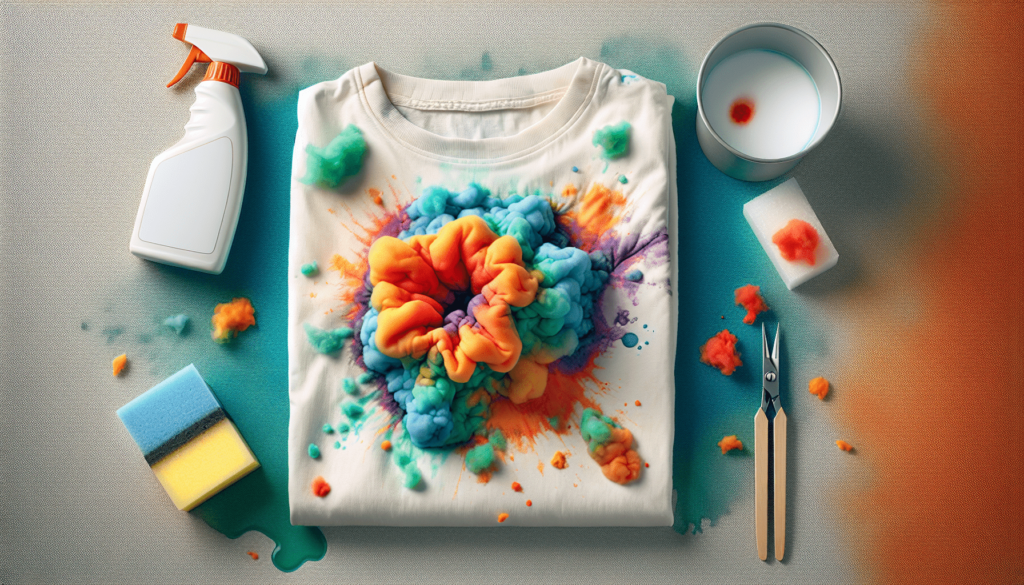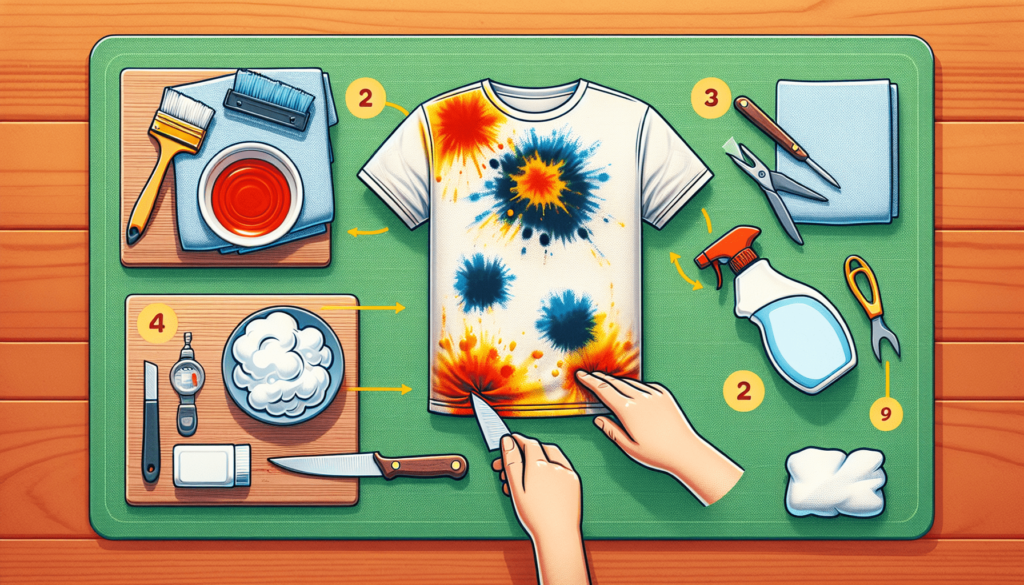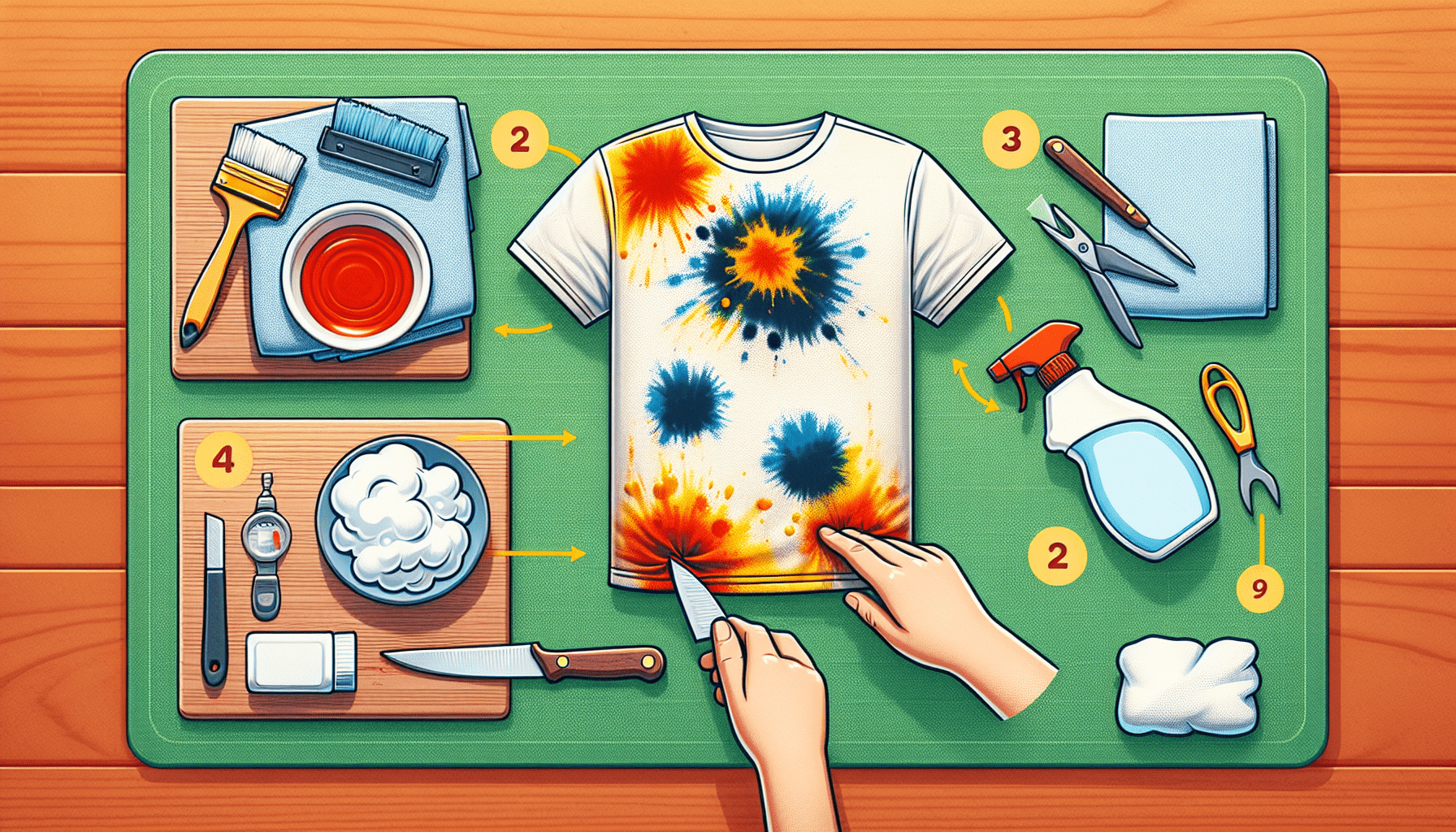In this informative article, you will discover effective techniques on how to safely remove puffy paint from fabric. Whether it’s an accidental spill or a desire to revitalize your fabric, these proven methods will guide you in effectively eliminating this stubborn substance. By following simple step-by-step instructions, you can restore your fabric to its original state, ensuring a seamless transition without any lasting reminders of the unwanted puffy paint.
Gather Essential Supplies
Before starting the process of removing puffy paint from fabric, it is important to gather all the necessary supplies. This will ensure that you have everything at hand and can proceed smoothly with the removal process. Here are the essential supplies you will need:
Rubbing alcohol
Rubbing alcohol is a powerful solvent that can effectively dissolve and remove puffy paint stains from fabric. It is readily available at most drugstores and can be an effective tool in your stain removal arsenal.
Cotton balls
Cotton balls are soft and absorbent, making them an ideal choice for applying rubbing alcohol to the stained fabric. They can help in evenly distributing the rubbing alcohol and lifting the puffy paint off the fabric.
Clean cloth
Having a clean cloth is essential during the removal process. It will be used for blotting and removing the paint residue. A soft, lint-free cloth is recommended to avoid leaving any fibers on the fabric.
Scraping tool
A scraping tool can be handy for gently scraping off excess puffy paint from the fabric. It is crucial to be cautious while using a scraping tool to prevent any damage to the fabric.
Liquid laundry detergent
Liquid laundry detergent can come to the rescue when dealing with stubborn puffy paint stains. It contains enzymes that can help break down and lift the paint from the fabric fibers.
Having these essential supplies at hand will save both time and effort during the puffy paint removal process. Let’s proceed to the next step.
Test the Removal Method
Before applying any stain removal method, it is crucial to test it on a hidden or inconspicuous area of the fabric. This will help determine the fabric’s reaction to the chosen method and ensure that it doesn’t cause any further damage. Follow these steps to test the removal method:
Choose a hidden area
Select a small, discreet area of the fabric, such as an inside seam or hem, to perform the removal test. This area should not be easily visible, as any adverse effects could become noticeable and diminish the fabric’s appearance.
Apply rubbing alcohol
Take a cotton ball and dampen it with rubbing alcohol. Gently apply the rubbing alcohol to the chosen hidden area of the fabric. Ensure that you do not saturate the fabric with the rubbing alcohol.
Blot with a clean cloth
After applying the rubbing alcohol, blot the area with a clean cloth. Check for any adverse reactions, such as color bleeding or fabric damage. If there are no negative effects, proceed with confidence to the next step. However, if there are any noticeable issues, it is advisable to seek professional assistance or consider an alternative removal method.

Apply Rubbing Alcohol
Now that you have successfully tested the removal method, it’s time to apply rubbing alcohol to the actual puffy paint stain on the fabric. Follow these steps for optimum results:
Dampen a cotton ball
Take a cotton ball and dampen it with rubbing alcohol. Ensure that the cotton ball is not dripping excessively to prevent the rubbing alcohol from saturating the fabric.
Gently rub the puffy paint
Using the dampened cotton ball, gently rub the puffy paint stain in a circular motion. Apply consistent pressure to ensure that the rubbing alcohol penetrates the paint and begins to break it down.
Blot the paint until it starts to lift
As you rub the puffy paint with the rubbing alcohol, you will notice that the paint starts to lift off the fabric. Continuously blot the area with a clean cloth to remove the dissolved paint. Repeat this process until you have successfully lifted off as much paint as possible.
Scrape Off Excess Paint
While the rubbing alcohol method can effectively remove a significant portion of the puffy paint, there may still be some residual paint left on the fabric. To tackle this, follow these steps to scrape off the excess paint:
Use a scraping tool
Take a scraping tool, such as a plastic spoon or a dull knife, and gently scrape off any excess puffy paint from the fabric. Be cautious while using the scraping tool to avoid damaging the fabric.
Be gentle to avoid damaging the fabric
When scraping off the excess paint, it is crucial to be gentle and patient. Apply minimal pressure to prevent any fabric fibers from getting caught in the scraping tool. Moving the tool back and forth delicately can help loosen and remove the remaining paint.
Remove as much paint as possible
Continue scraping off the excess paint until you have removed as much as possible. Take your time and ensure that you are being careful not to cause any unnecessary damage to the fabric. Once you have removed the majority of the paint, move on to the next step to complete the removal process.

Treat With Liquid Laundry Detergent
To further break down any remaining paint and lift it from the fabric fibers, treating the stained area with liquid laundry detergent can be highly effective. Follow these steps to proceed with this stain removal technique:
Apply a small amount of liquid laundry detergent
Take a small amount of liquid laundry detergent and apply it directly to the remaining puffy paint stain on the fabric. Be conservative with the amount of detergent used, as using too much may lead to excessive sudsing and make it harder to rinse out.
Gently rub the fabric
Using your fingers or a soft cloth, gently rub the liquid laundry detergent into the stained area. Ensure that you are penetrating the fibers and covering the entire stained portion of the fabric. The enzymes present in the detergent will start breaking down the paint particles.
Let it sit for a few minutes
Allow the liquid laundry detergent to sit on the stained area for a few minutes. This will give the enzymes enough time to dissolve and weaken the paint. The longer you let it sit, the better chance you have of successfully removing the remaining paint.
Blot With Clean Cloth
After treating the puffy paint stain with liquid laundry detergent, it’s time to blot the fabric to remove the dissolved paint and detergent residue. Follow these steps to ensure a thorough removal process:
Dampen a clean cloth
Take a clean cloth and dampen it with water. Ensure that the cloth is not overly saturated, as excess water can cause the paint particles to spread and potentially create new stains.
Blot the stained area
Gently blot the stained area with the dampened cloth. Apply slight pressure while blotting to transfer the dissolved paint and detergent residue onto the cloth. Continue blotting until you no longer see any paint transferring from the fabric to the cloth.
Continue blotting until the paint is no longer transferring
If you notice that the paint is still transferring onto the cloth, continue blotting the stained area. It may take several rounds of blotting to completely remove all traces of the puffy paint. Be patient and thorough to achieve the desired results.
Rinse and Repeat
After completing the initial removal steps, it is essential to rinse the fabric thoroughly and repeat the process if necessary. Follow these steps to ensure a comprehensive removal of the puffy paint stain:
Rinse the fabric under cold water
Take the fabric and rinse it thoroughly under cold running water. Ensure that all the detergent and paint residue is being washed away. Cold water is recommended, as hot water can set the stain and make it harder to remove.
Repeat the process if necessary
After rinsing, check the fabric to see if there are any remaining traces of puffy paint. If there are still visible stains, repeat the removal process from the beginning. Employ the rubbing alcohol, scraping, and detergent methods to target the persistent paint and achieve complete stain removal.
Check for any remaining paint
Once you have repeated the removal process and rinsed the fabric again, carefully inspect it for any lingering traces of puffy paint. If there are still stains present, it may be necessary to explore alternative methods or seek professional advice. However, in most cases, thorough repetition of the removal process should yield successful results.
Wash the Fabric
Once you have successfully removed the puffy paint stain from the fabric, it is crucial to wash it as usual to ensure freshness and cleanliness. Follow these steps to complete the removal process:
Wash the fabric as usual
wash the fabric as you would normally, following the care instructions provided. Use a regular laundry detergent suitable for the fabric type, and wash it with similar-colored items to prevent any dye transfer. This step will help eliminate any remaining traces of the paint and detergent residue.
Use a regular laundry detergent
Choose a laundry detergent that is appropriate for the fabric type and is free from any harsh chemicals that could damage the fabric. It is advisable to use a mild detergent that is specially formulated for delicate fabrics.
Check if the paint is completely removed
After washing, carefully inspect the fabric to ensure that the puffy paint stain is completely removed. If there are no visible stains, you have successfully removed the puffy paint and can proceed to dry and use the fabric as desired. However, if there are still some remnants of the stain, consider exploring alternative removal methods or seeking professional assistance.
Try Vinegar Solution
If the puffy paint stain persists even after following the previous removal methods, using a vinegar solution can offer an additional approach to tackle the stubborn stain. Here’s how to use a vinegar solution for puffy paint removal:
Mix equal parts of vinegar and water
Take equal parts of vinegar and water and mix them together to create a vinegar solution. It is recommended to use white distilled vinegar, as it is known for its stain-removing properties and is safe for most fabrics.
Apply the solution to the stain
Dampen a clean cloth with the vinegar solution and carefully apply it to the puffy paint stain. Ensure that you are covering the entire stained area with the solution, allowing it to penetrate the paint particles.
Blot with a clean cloth
Using another clean cloth, gently blot the stained area to lift off the dissolved paint and vinegar solution. Continue blotting until you no longer see any traces of the stain transferring onto the cloth.
With the vinegar solution, you have an alternative method to address the stubborn puffy paint stains. However, exercise caution and perform a test on a hidden area before applying the solution to the entire stained area.
Use a Commercial Stain Remover
If all else fails and the puffy paint stain persists on the fabric, using a commercial stain remover can be the next course of action. Here’s how to effectively utilize a commercial stain remover:
Choose a stain remover suitable for the fabric
Select a commercial stain remover that is appropriate for the fabric you are working with. Read the product instructions to ensure that it is safe to use on the fabric type and follow any specific guidelines provided.
Follow the instructions on the product
Carefully follow the instructions on the commercial stain remover product to ensure optimal results and minimize the risk of damaging the fabric. Guidelines regarding application, waiting times, and rinsing should be meticulously followed.
Apply and blot as directed
Apply the commercial stain remover to the puffy paint stain, following the instructions provided. Gently blot the stained area with a clean cloth, ensuring that you are removing the dissolved paint and stain remover residue.
When using a commercial stain remover, it is essential to exercise caution and perform a test on a hidden area of the fabric beforehand. This will help ensure compatibility with the fabric and minimize the risk of further damage.
In conclusion, removing puffy paint from fabric requires careful consideration and the right approach. By gathering essential supplies, testing the removal method, using rubbing alcohol, scraping off excess paint, treating with liquid laundry detergent, blotting with a clean cloth, rinsing and repeating if necessary, washing the fabric, trying a vinegar solution, or utilizing a commercial stain remover, you can successfully restore your fabric to its former glory. Remember to always follow the fabric’s care instructions and take appropriate safety precautions during the removal process. With patience and diligence, you can bid farewell to those unsightly puffy paint stains and enjoy your fabric in its pristine condition once again.



